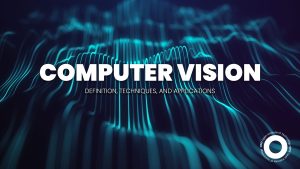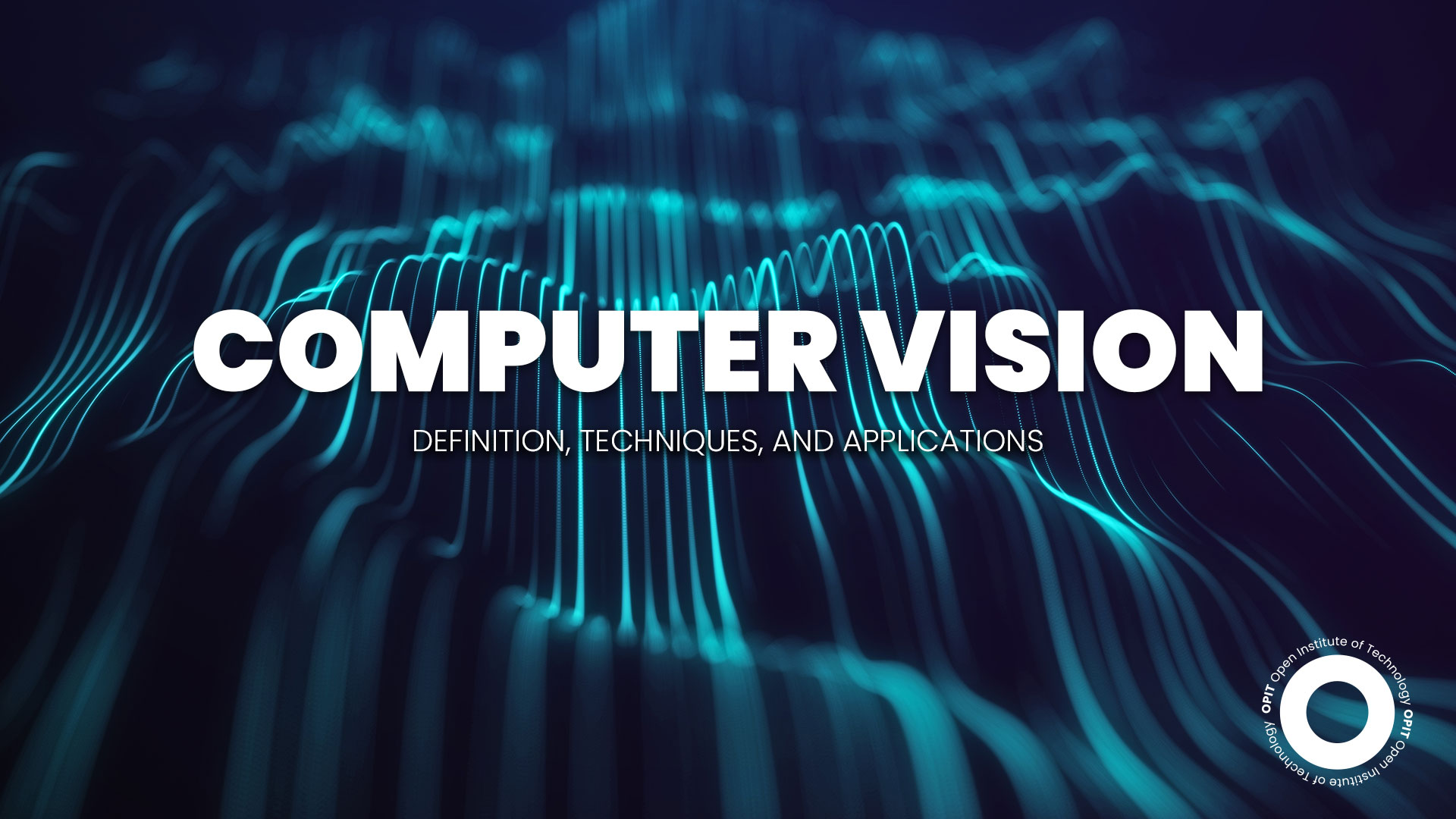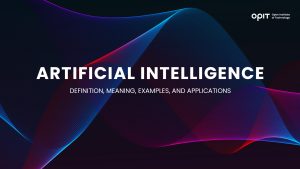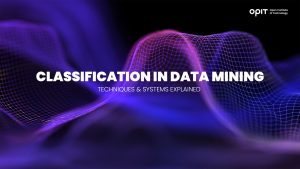

For most people, identifying objects surrounding them is an easy task.
Let’s say you’re in your office. You can probably casually list objects like desks, computers, filing cabinets, printers, and so on. While this action seems simple on the surface, human vision is actually quite complex.
So, it’s not surprising that computer vision – a relatively new branch of technology aiming to replicate human vision – is equally, if not more, complex.
But before we dive into these complexities, let’s understand the basics – what is computer vision?
Computer vision is an artificial intelligence (AI) field focused on enabling computers to identify and process objects in the visual world. This technology also equips computers to take action and make recommendations based on the visual input they receive.
Simply put, computer vision enables machines to see and understand.
Learning the computer vision definition is just the beginning of understanding this fascinating field. So, let’s explore the ins and outs of computer vision, from fundamental principles to future trends.
History of Computer Vision
While major breakthroughs in computer vision have occurred relatively recently, scientists have been training machines to “see” for over 60 years.
To do the math – the research on computer vision started in the late 1950s.
Interestingly, one of the earliest test subjects wasn’t a computer. Instead, it was a cat! Scientists used a little feline helper to examine how their nerve cells respond to various images. Thanks to this experiment, they concluded that detecting simple shapes is the first stage in image processing.
As AI emerged as an academic field of study in the 1960s, a decade-long quest to help machines mimic human vision officially began.
Since then, there have been several significant milestones in computer vision, AI, and deep learning. Here’s a quick rundown for you:
- 1970s – Computer vision was used commercially for the first time to help interpret written text for the visually impaired.
- 1980s – Scientists developed convolutional neural networks (CNNs), a key component in computer vision and image processing.
- 1990s – Facial recognition tools became highly popular, thanks to a shiny new thing called the internet. For the first time, large sets of images became available online.
- 2000s – Tagging and annotating visual data sets were standardized.
- 2010s – Alex Krizhevsky developed a CNN model called AlexNet, drastically reducing the error rate in image recognition (and winning an international image recognition contest in the process).
Today, computer vision algorithms and techniques are rapidly developing and improving. They owe this to an unprecedented amount of visual data and more powerful hardware.
Thanks to these advancements, 99% accuracy has been achieved for computer vision, meaning it’s currently more accurate than human vision at quickly identifying visual inputs.
Fundamentals of Computer Vision
New functionalities are constantly added to the computer vision systems being developed. Still, this doesn’t take away from the same fundamental functions these systems share.
Image Acquisition and Processing
Without visual input, there would be no computer vision. So, let’s start at the beginning.
The image acquisition function first asks the following question: “What imaging device is used to produce the digital image?”
Depending on the device, the resulting data can be a 2D, 3D image, or an image sequence. These images are then processed, allowing the machine to verify whether the visual input contains satisfying data.
Feature Extraction and Representation
The next question then becomes, “What specific features can be extracted from the image?”
By features, we mean measurable pieces of data unique to specific objects in the image.
Feature extraction focuses on extracting lines and edges and localizing interest points like corners and blobs. To successfully extract these features, the machine breaks the initial data set into more manageable chunks.
Object Recognition and Classification
Next, the computer vision system aims to answer: “What objects or object categories are present in the image, and where are they?”
This interpretive technique recognizes and classifies objects based on large amounts of pre-learned objects and object categories.
Image Segmentation and Scene Understanding
Besides observing what is in the image, today’s computer vision systems can act based on those observations.
In image segmentation, computer vision algorithms divide the image into multiple regions and examine the relevant regions separately. This allows them to gain a full understanding of the scene, including the spatial and functional relationships between the present objects.
Motion Analysis and Tracking
Motion analysis studies movements in a sequence of digital images. This technique correlates to motion tracking, which follows the movement of objects of interest. Both techniques are commonly used in manufacturing for monitoring machinery.
Key Techniques and Algorithms in Computer Vision
Computer vision is a fairly complex task. For starters, it needs a huge amount of data. Once the data is all there, the system runs multiple analyses to achieve image recognition.
This might sound simple, but this process isn’t exactly straightforward.
Think of computer vision as a detective solving a crime. What does the detective need to do to identify the criminal? Piece together various clues.
Similarly (albeit with less danger), a computer vision model relies on colors, shapes, and patterns to piece together an object and identify its features.
Let’s discuss the techniques and algorithms this model uses to achieve its end result.
Convolutional Neural Networks (CNNs)
In computer vision, CNNs extract patterns and employ mathematical operations to estimate what image they’re seeing. And that’s all there really is to it. They continue performing the same mathematical operation until they verify the accuracy of their estimate.
Deep Learning and Transfer Learning
The advent of deep learning removed many constraints that prevented computer vision from being widely used. On top of that, (and luckily for computer scientists!), it also eliminated all the tedious manual work.
Essentially, deep learning enables a computer to learn about visual data independently. Computer scientists only need to develop a good algorithm, and the machine will take care of the rest.
Alternatively, computer vision can use a pre-trained model as a starting point. This concept is known as transfer learning.
Edge Detection and Feature Extraction Techniques
Edge detection is one of the most prominent feature extraction techniques.
As the name suggests, it can identify the boundaries of an object and extract its features. As always, the ultimate goal is identifying the object in the picture. To achieve this, edge detection uses an algorithm that identifies differences in pixel brightness (after transforming the data into a grayscale image).
Optical Flow and Motion Estimation
Optical flow is a computer vision technique that determines how each point of an image or video sequence is moving compared to the image plane. This technique can estimate how fast objects are moving.
Motion estimation, on the other hand, predicts the location of objects in subsequent frames of a video sequence.
These techniques are used in object tracking and autonomous navigation.
Image Registration and Stitching
Image registration and stitching are computer vision techniques used to combine multiple images. Image registration is responsible for aligning these images, while image stitching overlaps them to produce a single image. Medical professionals use these techniques to track the progress of a disease.
Applications of Computer Vision
Thanks to many technological advances in the field, computer vision has managed to surpass human vision in several regards. As a result, it’s used in various applications across multiple industries.
Robotics and Automation
Improving robotics was one of the original reasons for developing computer vision. So, it isn’t surprising this technique is used extensively in robotics and automation.
Computer vision can be used to:
- Control and automate industrial processes
- Perform automatic inspections in manufacturing applications
- Identify product and machine defects in real time
- Operate autonomous vehicles
- Operate drones (and capture aerial imaging)
Security and Surveillance
Computer vision has numerous applications in video surveillance, including:
- Facial recognition for identification purposes
- Anomaly detection for spotting unusual patterns
- People counting for retail analytics
- Crowd monitoring for public safety
Healthcare and Medical Imaging
Healthcare is one of the most prominent fields of computer vision applications. Here, this technology is employed to:
- Establish more accurate disease diagnoses
- Analyze MRI, CAT, and X-ray scans
- Enhance medical images interpreted by humans
- Assist surgeons during surgery
Entertainment and Gaming
Computer vision techniques are highly useful in the entertainment industry, supporting the creation of visual effects and motion capture for animation.
Good news for gamers, too – computer vision aids augmented and virtual reality in creating the ultimate gaming experience.
Retail and E-Commerce
Self-check-out points can significantly enhance the shopping experience. And guess what can help establish them? That’s right – computer vision. But that’s not all. This technology also helps retailers with inventory management, allowing quicker detection of out-of-stock products.
In e-commerce, computer vision facilitates visual search and product recommendation, streamlining the (often frustrating) online purchasing process.
Challenges and Limitations of Computer Vision
There’s no doubt computer vision has experienced some major breakthroughs in recent years. Still, no technology is without flaws.
Here are some of the challenges that computer scientists hope to overcome in the near future:
- The data for training computer vision models often lack in quantity or quality.
- There’s a need for more specialists who can train and monitor computer vision models.
- Computers still struggle to process incomplete, distorted, and previously unseen visual data.
- Building computer vision systems is still complex, time-consuming, and costly.
- Many people have privacy and ethical concerns surrounding computer vision, especially for surveillance.
Future Trends and Developments in Computer Vision
As the field of computer vision continues to develop, there should be no shortage of changes and improvements.
These include integration with other AI technologies (such as neuro-symbolic and explainable AI), which will continue to evolve as developing hardware adds new capabilities and capacities that enhance computer vision. Each advancement brings with it the opportunity for other industries (and more complex applications). Construction gives us a good example, as computer vision takes us away from the days of relying on hard hats and signage, moving us toward a future in which computers can actively detect, and alert site foremen too, unsafe behavior.
The Future Looks Bright for Computer Vision
Computer vision is one of the most remarkable concepts in the world of deep learning and artificial intelligence. This field will undoubtedly continue to grow at an impressive speed, both in terms of research and applications.
Are you interested in further research and professional development in this field? If yes, consider seeking out high-quality education in computer vision.
Related posts

Bring talented tech experts together, set them a challenge, and give them a deadline. Then, let them loose and watch the magic happen. That, in a nutshell, is what hackathons are all about. They’re proven to be among the most productive tech events when it comes to solving problems and accelerating innovation.
What Is a Hackathon?
Put simply, a hackathon is a short-term event – often lasting just a couple of days, or sometimes even only a matter of hours – where tech experts come together to solve a specific problem or come up with ideas based on a central theme or topic. As an example, teams might be tasked with discovering a new way to use AI in marketing or to create an app aimed at improving student life.
The term combines the words “hack” and “marathon,” due to how participants (hackers or programmers) are encouraged to work around-the-clock to create a prototype, proof-of-concept, or new solution. It’s similar to how marathon runners are encouraged to keep running, putting their skills and endurance to the test in a race to the finish line.
The Benefits of Hackathons
Hackathons provide value both for the companies that organize them and the people who take part. Companies can use them to quickly discover new ideas or overcome challenges, for example, while participants can enjoy testing their skills, innovating, networking, and working either alone or as part of a larger team.
Benefits for Companies and Sponsors
Many of the world’s biggest brands have come to rely on hackathons as ways to drive innovation and uncover new products, services, and opportunities. Meta, for example, the brand behind Facebook, has organized dozens of hackathons, some of which have led to the development of well-known Facebook features, like the “Like” button. Here’s how hackathons help companies:
- Accelerate Innovation: In fast-moving fields like technology, companies can’t always afford to spend months or years working on new products or features. They need to be able to solve problems quickly, and hackathons create the necessary conditions to deliver rapid success.
- Employee Development: Leading companies like Meta have started to use annual hackathons as a way to not only test their workforce’s skills but to give employees opportunities to push themselves and broaden their skill sets.
- Internal Networking: Hackathons also double up as networking events. They give employees from different teams, departments, or branches the chance to work with and learn from one another. This, in turn, can promote or reinforce team-oriented work cultures.
- Talent Spotting: Talents sometimes go unnoticed, but hackathons give your workforce’s hidden gems a chance to shine. They’re terrific opportunities to see who your best problem solvers and most creative thinkers at.
- Improving Reputation: Organizing regular hackathons helps set companies apart from their competitors, demonstrating their commitment to innovation and their willingness to embrace new ideas. If you want your brand to seem more forward-thinking and innovative, embracing hackathons is a great way to go about it.
Benefits for Participants
The hackers, developers, students, engineers, and other people who take part in hackathons arguably enjoy even bigger and better benefits than the businesses behind them. These events are often invaluable when it comes to upskilling, networking, and growing, both personally and professionally. Here are some of the main benefits for participants, explained:
- Learning and Improvement: Hackathons are golden opportunities for participants to gain knowledge and skills. They essentially force people to work together, sharing ideas, contributing to the collective, and pushing their own boundaries in pursuit of a common goal.
- Networking: While some hackathons are purely internal, others bring together different teams or groups of people from different schools, businesses, and places around the world. This can be wonderful for forming connections with like-minded individuals.
- Sense of Pride: Everyone feels a sense of pride after accomplishing a project or achieving a goal, but this often comes at the end of weeks or months of effort. With hackathons, participants can enjoy that same satisfying feeling after just a few hours or a couple of days of hard work.
- Testing Oneself: A hackathon is an amazing chance to put one’s skills to the test and see what one is truly capable of when given a set goal to aim for and a deadline to meet. Many participants are surprised to see how well they respond to these conditions.
- Boosting Skills: Hackathons provide the necessary conditions to hone and improve a range of core soft skills, such as teamwork, communication, problem-solving, organization, and punctuality. By the end, participants often emerge with more confidence in their abilities.
Hackathons at OPIT
The Open Institute of Technology (OPIT) understands the unique value of hackathons and has played its part in sponsoring these kinds of events in the past. OPIT was one of the sponsors behind ESCPHackathon 6, for example, which involved 120 students given AI-related tasks, with mentorship and guidance from senior professionals and developers from established brands along the way.
Marco Fediuc, one of the participants, summed up the mood in his comments:
“The hackathon was a truly rewarding experience. I had the pleasure of meeting OPIT classmates and staff and getting to know them better, the chance to collaborate with brilliant minds, and the opportunity to take part in an exciting and fun event.
“Participating turned out to be very useful because I had the chance to work in a fast-paced, competitive environment, and it taught me what it means to stay calm and perform under pressure… To prospective Computer Science students, should a similar opportunity arise, I can clearly say: Don’t underestimate yourselves!”
The new year will also see the arrival of OPIT Hackathon 2026, giving more students the chance to test their skills, broaden their networks, and enjoy the one-of-a-kind experiences that these events never fail to deliver. This event is scheduled to be held February 13-15, 2026, and is open to all OPIT Bachelor’s and Master’s students, along with recent graduates. Interested parties have until February 1 to register.

The Open Institute of Technology (OPIT) recently held its first-ever career fair to showcase its wide array of career education options and services. Representatives from numerous high-profile international companies were in attendance, and students enjoyed unprecedented opportunities to connect with business leaders, expand their professional networks, and pave the way for success in their future careers.
Here’s a look back at the event and how it ties into OPIT’s diverse scope of career services.
Introducing OPIT
For those who aren’t yet familiar, OPIT is an EU-accredited Higher Education Institution, offering online degrees in technological fields such as computer science, data science, artificial intelligence, cybersecurity, and digital business. Aimed at making high-level tech education accessible to all, OPIT has assembled a stellar team of tutors and experts to train the tech leaders of tomorrow.
The First OPIT Career Fair
OPIT’s first career fair was held on November 19 and 20. And as with OPIT’s lectures, it was an exclusively online event, which ensured that every attendee had equal access to key lectures and information. Interested potential students from all over the world were able to enjoy the same great experience, demonstrating a core principle that OPIT has championed from the very start – the principles of accessibility and the power of virtual learning.
More than a dozen leading international companies took part in the event, with the full guest list including representatives from:
- Deloitte
- Dylog Hitech
- EDIST Engineering Srl
- Tinexta Cyber
- Datapizza
- RWS Group
- WE GRELE FRANCE
- Avatar Investments
- Planet Farms
- Coolshop
- Hoist Finance Italia
- Gruppo Buffetti S.p.A
- Nesperia Group
- Fusion AI Labs
- Intesi Group
- Reply
- Mindsight Ventures
This was a fascinating mix of established enterprises and emerging players. Deloitte, for example, is one of the largest professional services networks in the world in terms of both revenue and number of employees. Mindsight Ventures, meanwhile, is a newer but rapidly emerging name in the fields of AI and business intelligence.
The Response
The first OPIT career fair was a success, with many students in attendance expressing their joy at being able to connect with such a strong lineup of prospective employers.
OPIT Founder and Director Riccardo Ocleppo had this to say:
“I often say internally that our connection with companies – through masterclasses, thesis and capstone projects, and career opportunities – is the ‘cherry on the cake’ of the OPIT experience!
“It’s also a core part of our mission: making higher education more practical, more connected, and more aligned with what happens in the real world.
“Our first Career Fair says a lot about our commitment to building an end-to-end learning and professional growth experience for our community of students.
“Thank you to the Student and Career Services team, and to Stefania Tabi for making this possible.”
Representatives from some of the companies that attended also shared positive impressions of the event. A representative from Nesperia Group, for example, said:
“Nesperia Group would like to thank OPIT for the warm welcome we received during the OPIT Career Day. We were pleased to be part of the event because we met many talented young professionals. Their curiosity and their professional attitude really impressed us, and it’s clear that OPIT is doing an excellent job supporting their growth. We really believe that events like these are important because they can create a strong connection between companies and future professionals.”
The Future
Given the enormous success of the first OPIT career fair, it’s highly likely that students will be able to enjoy more events like this in the years to come. OPIT is clearly committed to making the most of its strong business connections and remarkable network to provide opportunities for growth, development, and employment, bringing students and businesses together.
Future events will continue to allow students to connect with some of the biggest businesses in the world, along with emerging names in the most exciting and innovative tech fields. This should allow OPIT graduates to enter the working world with strong networks and firm connections already established. That, in turn, should make it easier for them to access and enjoy a wealth of beneficial professional opportunities.
Given that OPIT also has partnerships in place with numerous other leading organizations, like Hype, AWS, and Accenture, the number and variety of the companies potentially making appearances at career fairs in the future should no doubt increase dramatically.
Other Career Services at OPIT
The career fair is just one of many ways in which OPIT leverages its company connections and offers professional opportunities and career support to its students. Other key career services include:
- Career Coaching: Students are able to schedule one-on-one sessions with their own mentors and career advisors. They can receive feedback on their resumes, practice and improve their interview skills, or work on clear action plans that align with their exact professional goals.
- Resource Hub: The OPIT Resource Hub is jam-packed with helpful guides and other resources to help students plan out and take smart steps in their professional endeavors. With detailed insights and practical tips, it can help tech graduates get off to the best possible start.
- Career Events: The career fair is only one of several planned career-related events organized by OPIT. Other events are planned to give students the chance to learn from and engage with industry experts and leading tech firms, with workshops, career skills days, and more.
- Internships: OPIT continues to support students after graduation, offering internship opportunities with leading tech firms around the world. These internships are invaluable for gaining experience and forging connections, setting graduates up for future success.
- Peer Mentoring: OPIT also offers a peer mentoring program in which existing students can team up with OPIT alumni to enjoy the benefits of their experience and unique insights.
These services – combined with the recent career day – clearly demonstrate OPIT’s commitment to not merely educating the tech leaders of the future, but also to supporting their personal and professional development beyond the field of education, making it easier for them to enter the working world with strong connections and unrivaled opportunities.
Have questions?
Visit our FAQ page or get in touch with us!
Write us at +39 335 576 0263
Get in touch at hello@opit.com
Talk to one of our Study Advisors
We are international
We can speak in:


